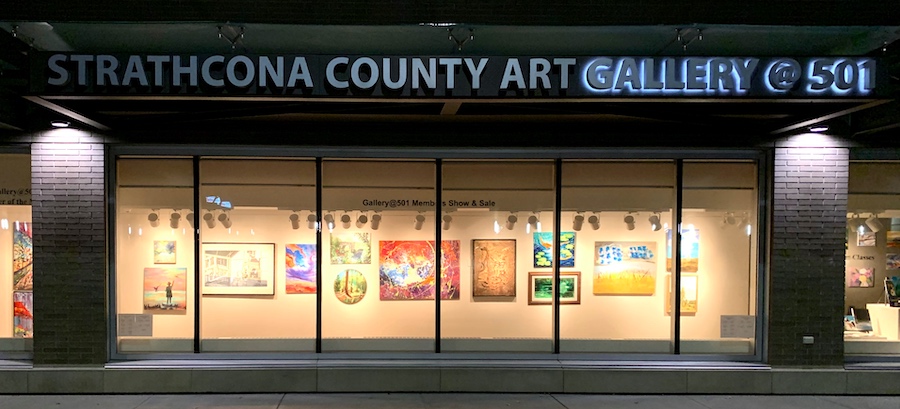
Photos and review by Travis McNaught
When I first read about a new exhibit at the Gallery@501 in Strathcona County, I wondered most about what the title could mean: Reckoning | Unraveling | Reclaiming a journey to self. Was it a three-part lecture about the Holy Trinity? Perhaps a guided meditation to achieve enlightenment?
When I instead found that it was a collection of various poems, I promptly typed the address in my phone and cleared a space in my schedule for a reflective study break. Reckoning ran from September 10 to October 6 and contained select works of Nisha Patel, Temi Phillips, and Adetola Adedipe (aloT of Poetry).
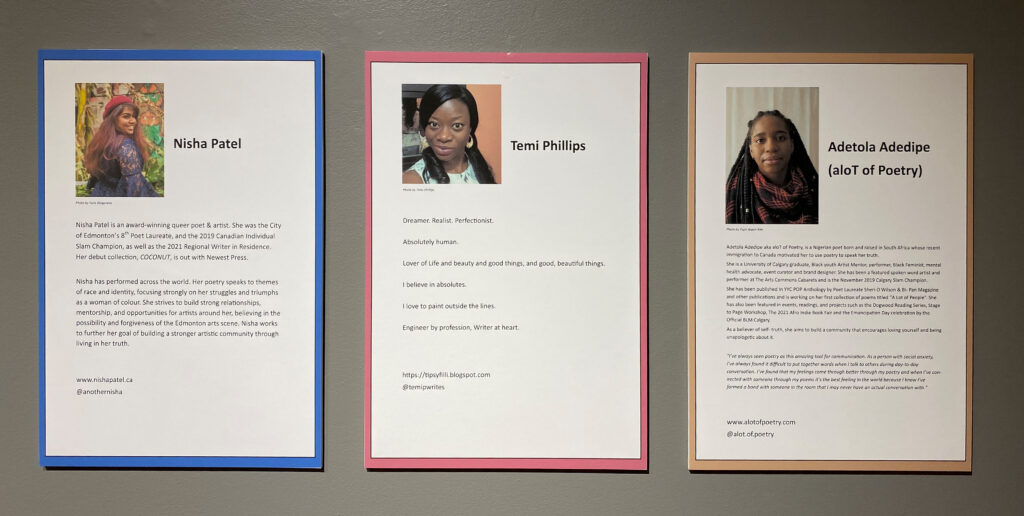
I drove 30 minutes to the gallery@501 and was pleased to find a nearby free 2-hour parking lot. I walked into the unassuming entrance with little branding for the gallery, much more understated than the nearby restaurants and library, and was greeted by signs for both a voting poll down the hall and the two-exhibit gallery through the doors on the right.
In the gallery I was greeted by a tone played by the doors and a welcoming “Hello!” from the back of the room. A staff member welcomed me to the exhibit, explaining the featured works, artists, and range of topics being explored by the pieces on display. I learnt there was another exhibit in the other half of the room that I wasn’t aware of, called Amplify, which I was told explored notions of identity through portraits and multimedia art pieces. Bonus!
The employee made me aware of the sensitive subject matter included in Reckoning, warning that some words and topics might be difficult for some viewers to get through. I thanked her for the warm welcome and provided proof of vaccination, and she let me freely continue to explore the large room on my own.
I imagine that if I hadn’t gone at the very last minute, there might have been more people attending, but for this visit it was just me and the company of the poetry and visual arts covering each half of the room.
There was no music playing overhead and though I was at first disappointed as it could have helped the atmosphere, I later found the silence appropriate for reflective reading. The left half of the room had poems covering the walls, and one hanging from the ceiling at chest-height in the middle of the space.
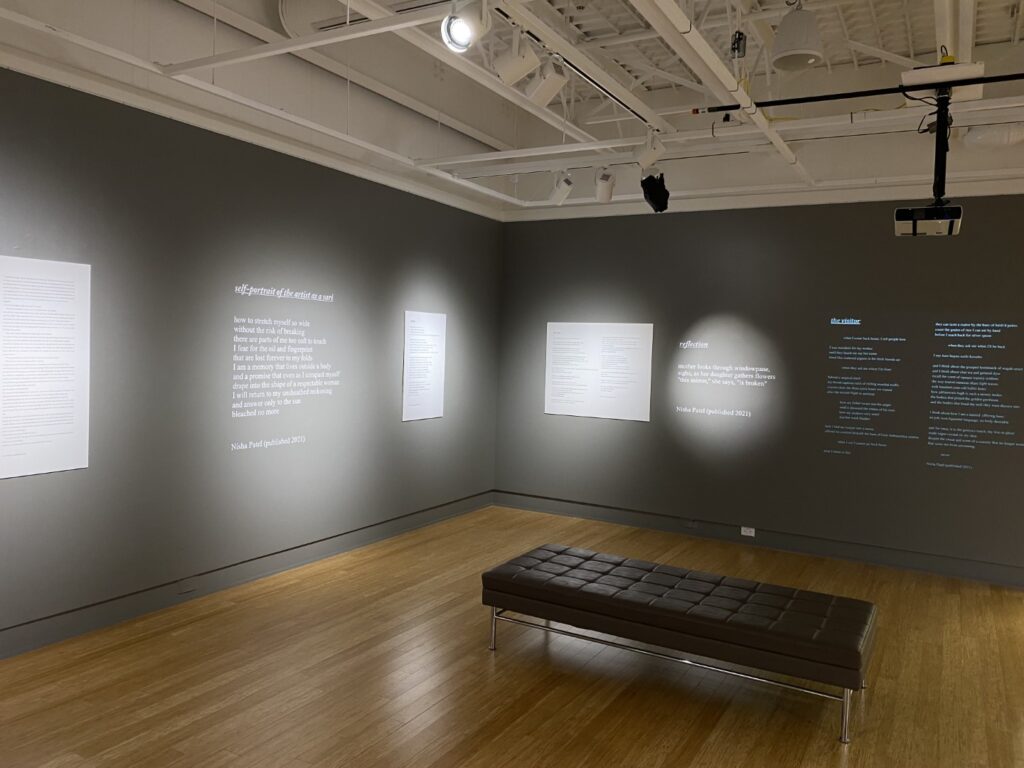
A grid of nine small square boards (organized in a mosaic reminiscent of an Instagram feed) with portraits and poems on them immediately stood out.
Three showed portrait photographs of Adetola Adedipe, and the other six were short poems or sayings.
The pieces with poems all echoed sentiments of empowerment and belonging for Black women, and the portraits all showed Adedipe sporting a T-shirt that says “Black Girl Magic ”.
Each square had the same tag on the bottom: @alot.of.poetry, and when I got home I found that the squares all looked as if they came directly from the instagram account under the same name (in fact I continued digging and found that they were a collection of six hand-picked posts). It’s safe to say that Adedipe gained a follower that day.
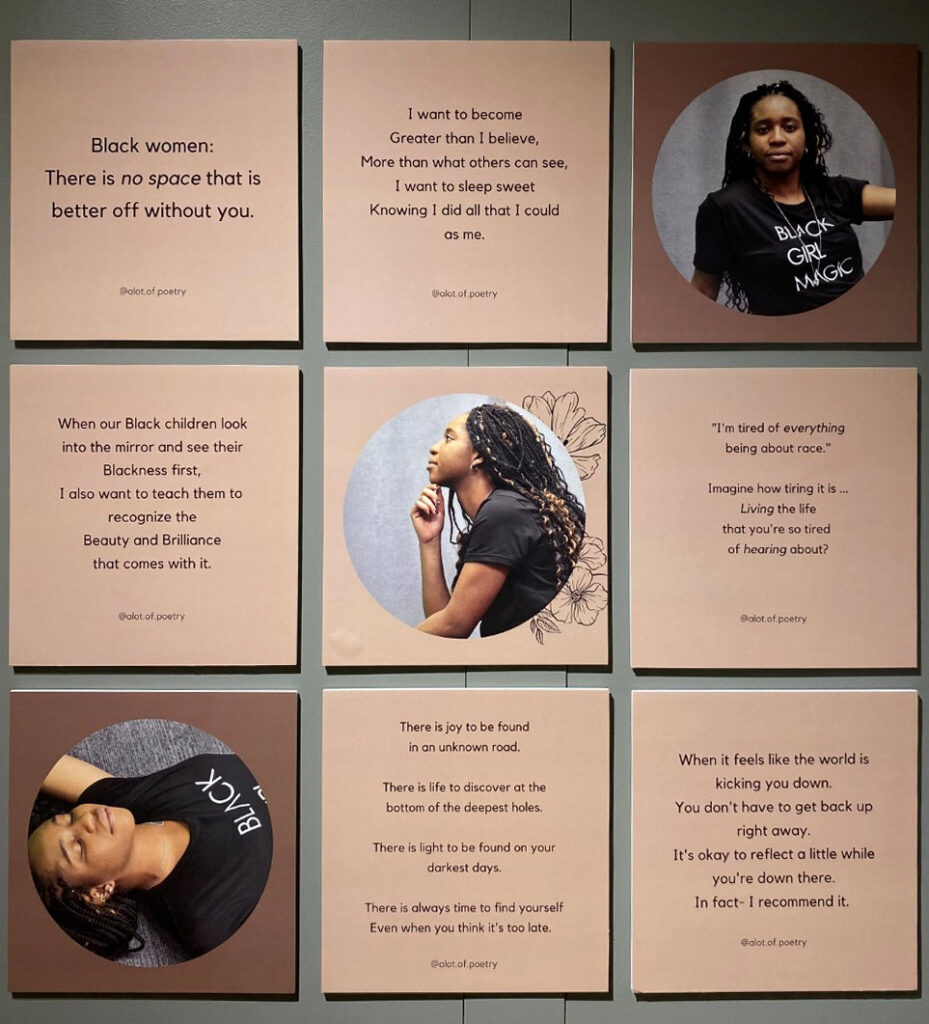
The piece from Adedipe with which I connected the most was ‘Words Matter’, a longer free-verse poem with a steady beating rhythm all throughout, shaping a silent reading into an inner spoken-word delivery. The poem speaks about white privilege, and aspects of living as a person of colour, and raising a family in North America.
I found myself feeling distant as I read, but was still able to feel the empathy and injustice the poem had drumming strong throughout its verses. This was also the first piece in which I found a recurring issue: typos. In this one piece I found (and stumbled on) a missing word and a missing apostrophe, something which might not affect some readers, but will ultimately impact the immersive reading experience of many others.
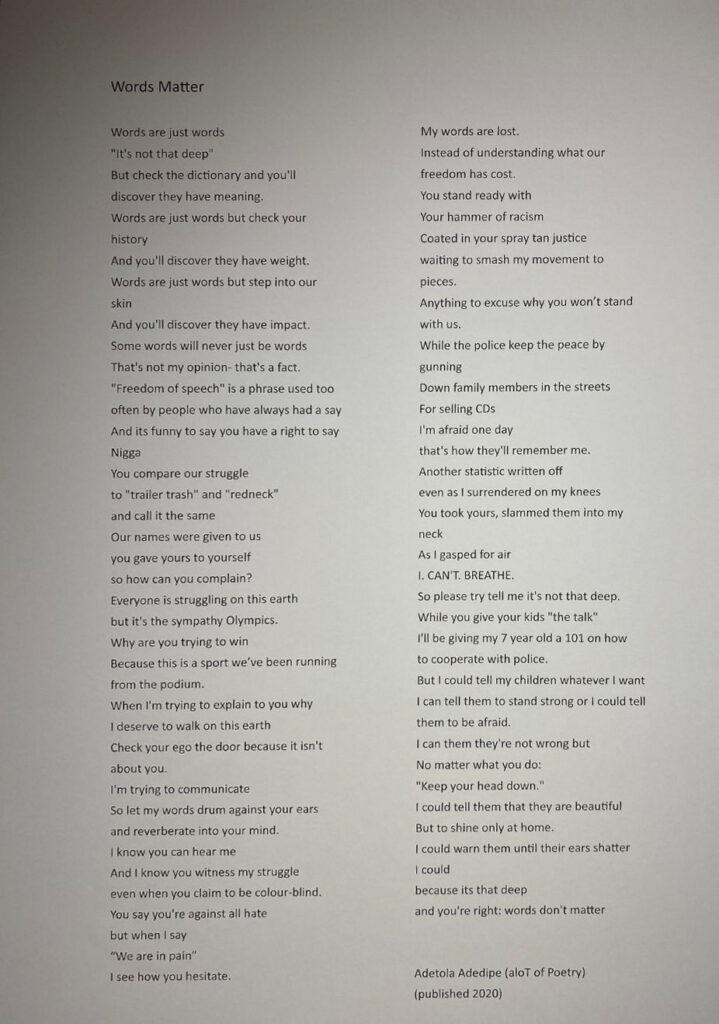
A longer piece by Temi Phillips called ‘Beneath These Skins’ was perhaps a reason for a warning before entering, as it mentions experiences of sexual abuse, racism, and self-harm. The piece, which is freeform and narrative-driven, recounts a story in which Phillips met a woman at a conference and connected over shared experiences. Over the course of the few-minute read, viewers scratch the surface of the poet’s “damagedness” and learn in the end that one does not always have to be the strong one. I found the sensitive subjects weren’t explored too in-depth so as to deter me from reading, but rather allowed for a vulnerable poem to elicit stronger emotions after my reading.
Once again however, my immersion was broken when a sentence went as followed on the page: “You don’t say anything about how you […]”. Despite this, Phillips was still able to deliver a transparent account of her life so efficiently in the piece that I got goosebumps when I arrived at the heartfelt ending.
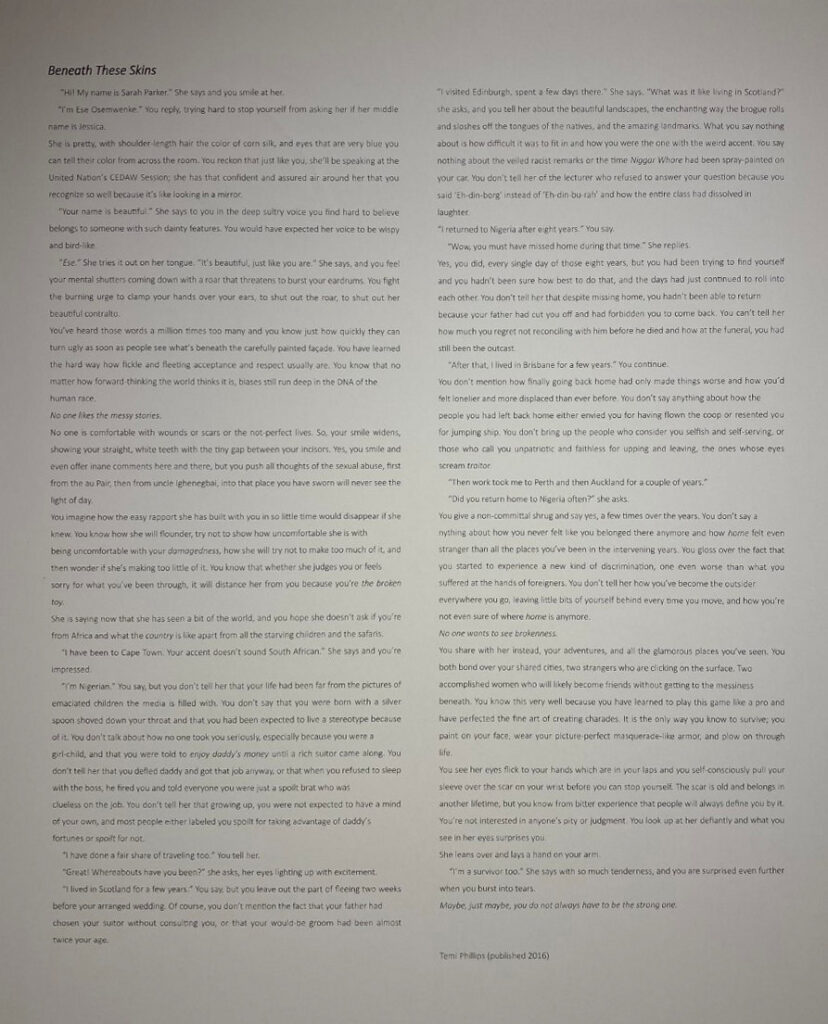
I approached the last poem and sat on the small bench near it, admiring how the piece was being projected onto a black background with white text, rather than a white board with black text like the others. This piece, ‘the visitor’, proved to be a challenging read, not because of the projector or the subject matter, but because of the language used (or rather languages).
Nisha Patel speaks about being back home in this poem, filled with rhythm, quotes, and powerful line breaks. As I read it, I realized that I didn’t understand many references to places or things, and felt tempted to look them up on my phone before finishing the short piece. Instead, I continued and by the ending, felt like I had only read two thirds of a full poem.
As I was about to look certain items up – “hum hagna nathi karatho”, “wagah-attari”, “jallianwala” – I instead thought about why Nisha Patel chose to include this specific piece in the exhibit. None of the other poems dealt with nearly as many topics which were foreign to me, and I realized that she had made that decision for a purpose.
I left the piece understanding that it spoke of a feeling of unbelonging, of being too changed to be welcomed back home, and I reflected on the idea that I was perhaps not meant to get an explanation for the parts I didn’t understand.
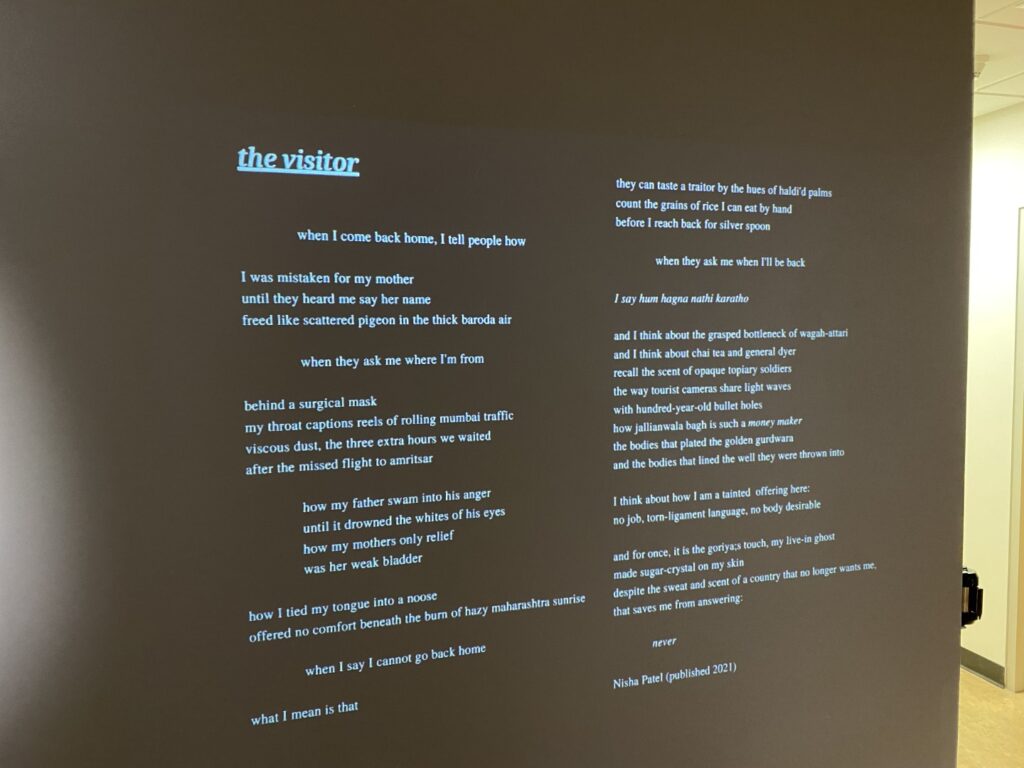
After around 20 minutes in the exhibit, I finished reading the last poem and decided to quickly check out the other section: Amplify, which included portraits and other multimedia pieces. I found that the change from poems and visual arts was slightly abrupt, as my own knowledge and experience limited me to recognize the forms and structures of poetry much more than the visual arts. Still, I enjoyed the creative uses of synthetic hair and other unusual mediums to create portraits and pieces that effectively complimented the poetry.
The employee thanked me for enjoying the exhibits, and excitedly told me about the one which would soon replace Reckoning called …bring a folding chair, which would run from October 9-30.
I stepped outside of the exhibit and made a new note on my phone, one which included the date of the next exhibit and the names of the three Reckoning poets to type into the search bars of local bookstores once I returned home.
Gallery@501 website
Related edmontonscene stories:
Interview with Edmonton Poet Laureate Nisha Patel
SkirtsAfire and Ballet Edmonton – Body of Words - Review


